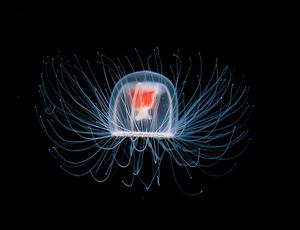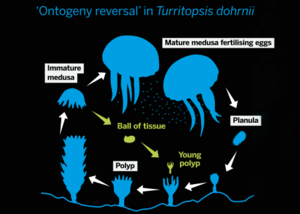Turritopsis dohrnii: Difference between revisions
Fitzgerald3 (talk | contribs) |
Fitzgerald3 (talk | contribs) |
||
| Line 4: | Line 4: | ||
<i>Turritopsis dohrnii</i> (previously classified as <i>Turritopsis nutricula</i><ref> Schuchert P. Revision of the European athecate hydroids and their medusae (Hydrozoa, Cnidaria): families Oceanidae and Pachycordylidae. Revue suisse de Zoologie. 2004 Jun 1;111(2):315-70. Available from: https://www.semanticscholar.org/paper/Revision-of-the-European-athecate-hydroids-and-and-Schuchert/e3d3dce80157e5ee98ecbe0bbe7d35eb36cbe82b?p2df | <i>Turritopsis dohrnii</i> (previously classified as <i>Turritopsis nutricula</i><ref> Schuchert P. Revision of the European athecate hydroids and their medusae (Hydrozoa, Cnidaria): families Oceanidae and Pachycordylidae. Revue suisse de Zoologie. 2004 Jun 1;111(2):315-70. Available from: https://www.semanticscholar.org/paper/Revision-of-the-European-athecate-hydroids-and-and-Schuchert/e3d3dce80157e5ee98ecbe0bbe7d35eb36cbe82b?p2df | ||
</ref>), commonly known as the immortal jellyfish or the Benjamin Button jellyfish<ref> Than K. "Immortal" Jellyfish Swarm World's Oceans [Internet]. National Geographic. 2009. Available from: https://www.nationalgeographic.com/animals/2009/01/immortal-jellyfish-swarm-oceans-animals/</ref>, is a small species of jellyfish known for its unique ability to revert back to an earlier life stage through transdifferentiation<ref> Schmich J, Kraus Y, De Vito D, Graziussi D, Boero F, Piraino S. Induction of reverse development in two marine Hydrozoans. Int J Dev Biol. 2007 Feb 1;51:45–56. Available from: https://www.researchgate.net/publication/6617831_Induction_of_reverse_development_in_two_marine_Hydrozoans</ref><ref> Piraino S, De Vito D, Schmich J, Bouillon J, Boero F. Reverse development in Cnidaria. Canadian Journal of Zoology. 2004 Nov 1;82(11):1748-54. Available from: https://www.researchgate.net/profile/Stefano_Piraino/publication/249542511_Reverse_development_in_Cnidaria/links/004635220749d81dc3000000/Reverse-development-in-Cnidaria.pdf</ref>. This ontogeny reversal renders the organism virtually immortal as this process has the potential to repeat itself indefinitely, although organismal death does still occur in its natural environment<ref> Piraino S, Boero F, Aeschbach B, Schmid V. Reversing the life cycle: medusae transforming into polyps and cell transdifferentiation in Turritopsis nutricula (Cnidaria, Hydrozoa). The Biological Bulletin. 1996 Jun 1;190(3):302-12. Available from: https://www.journals.uchicago.edu/doi/pdfplus/10.2307/1543022?casa_token=VCv_136r__UAAAAA%3ARVFGUXoAfbOsfuX2x2l8RiTdYNa4mgvDPrnVFQEo5KUbmRat544_LD8iRbOzKJjDNuSi38-gjDo7&</ref>. Reverse development can be triggered by a variety of stressors including starvation, changes in temperature or salinity, physical damage, or age-related deterioration<ref> Piraino S, De Vito D, Schmich J, Bouillon J, Boero F. Reverse development in Cnidaria. Canadian Journal of Zoology. 2004 Nov 1;82(11):1748-54. Available from: https://www.researchgate.net/profile/Stefano_Piraino/publication/249542511_Reverse_development_in_Cnidaria/links/004635220749d81dc3000000/Reverse-development-in-Cnidaria.pdf</ref>. | </ref>), commonly known as the immortal jellyfish or the Benjamin Button jellyfish<ref> Than K. "Immortal" Jellyfish Swarm World's Oceans [Internet]. National Geographic. 2009. Available from: https://www.nationalgeographic.com/animals/2009/01/immortal-jellyfish-swarm-oceans-animals/</ref>, is a small species of jellyfish known for its unique ability to revert back to an earlier life stage through transdifferentiation<ref> Schmich J, Kraus Y, De Vito D, Graziussi D, Boero F, Piraino S. Induction of reverse development in two marine Hydrozoans. Int J Dev Biol. 2007 Feb 1;51:45–56. Available from: https://www.researchgate.net/publication/6617831_Induction_of_reverse_development_in_two_marine_Hydrozoans</ref><ref> Piraino S, De Vito D, Schmich J, Bouillon J, Boero F. Reverse development in Cnidaria. Canadian Journal of Zoology. 2004 Nov 1;82(11):1748-54. Available from: https://www.researchgate.net/profile/Stefano_Piraino/publication/249542511_Reverse_development_in_Cnidaria/links/004635220749d81dc3000000/Reverse-development-in-Cnidaria.pdf</ref>. This ontogeny reversal renders the organism virtually immortal as this process has the potential to repeat itself indefinitely, although organismal death does still occur in its natural environment<ref> Piraino S, Boero F, Aeschbach B, Schmid V. Reversing the life cycle: medusae transforming into polyps and cell transdifferentiation in Turritopsis nutricula (Cnidaria, Hydrozoa). The Biological Bulletin. 1996 Jun 1;190(3):302-12. Available from: https://www.journals.uchicago.edu/doi/pdfplus/10.2307/1543022?casa_token=VCv_136r__UAAAAA%3ARVFGUXoAfbOsfuX2x2l8RiTdYNa4mgvDPrnVFQEo5KUbmRat544_LD8iRbOzKJjDNuSi38-gjDo7&</ref>. Reverse development can be triggered by a variety of stressors including starvation, changes in temperature or salinity, physical damage, or age-related deterioration<ref> Piraino S, De Vito D, Schmich J, Bouillon J, Boero F. Reverse development in Cnidaria. Canadian Journal of Zoology. 2004 Nov 1;82(11):1748-54. Available from: https://www.researchgate.net/profile/Stefano_Piraino/publication/249542511_Reverse_development_in_Cnidaria/links/004635220749d81dc3000000/Reverse-development-in-Cnidaria.pdf</ref>. | ||
<br><br> | <br><br> | ||
Although a rare ability, reverse development has been reported in several other Cnidaria species. Some of these include <i>Laodicea undulata</i><ref> De Vito D, Piraino S, Schmich J, Bouillon J, Boero F. Evidence of reverse development in Leptomedusae (Cnidaria, Hydrozoa): the case of Laodicea undulata (Forbes and Goodsir 1851). Marine Biology. 2006 May 1;149(2):339-46. Available from: https://link.springer.com/article/10.1007%2Fs00227-005-0182-3</ref>, <i>Aurelia</i> sp.<ref> He J, Zheng L, Zhang W, Lin Y. Life cycle reversal in Aurelia sp. 1 (Cnidaria, Scyphozoa). PloS one. 2015 Dec 21;10(12):e0145314. Available from: https://www.ncbi.nlm.nih.gov/pmc/articles/PMC4687044/</ref>, <i>Hydractinia carnea</i><ref> Schmich J, Kraus Y, De Vito D, Graziussi D, Boero F, Piraino S. Induction of reverse development in two marine Hydrozoans. Int J Dev Biol. 2007 Feb 1;51:45–56. Available from: https://www.researchgate.net/publication/6617831_Induction_of_reverse_development_in_two_marine_Hydrozoans</ref>, <i>Podocoryne carnea</i>, <i>Eleutheria dichotoma</i>, <i>Cladonema</i> sp. and <i>Cladonema uchidai</i>, and <i>Perarella schneideri</i><ref> Piraino S, Boero F, Aeschbach B, Schmid V. Reversing the life cycle: medusae transforming into polyps and cell transdifferentiation in Turritopsis nutricula (Cnidaria, Hydrozoa). The Biological Bulletin. 1996 Jun 1;190(3):302-12. Available from: https://www.journals.uchicago.edu/doi/pdfplus/10.2307/1543022?casa_token=VCv_136r__UAAAAA%3ARVFGUXoAfbOsfuX2x2l8RiTdYNa4mgvDPrnVFQEo5KUbmRat544_LD8iRbOzKJjDNuSi38-gjDo7&</ref>. | |||
Revision as of 06:41, 8 December 2020
Introduction

Turritopsis dohrnii (previously classified as Turritopsis nutricula[1]), commonly known as the immortal jellyfish or the Benjamin Button jellyfish[2], is a small species of jellyfish known for its unique ability to revert back to an earlier life stage through transdifferentiation[3][4]. This ontogeny reversal renders the organism virtually immortal as this process has the potential to repeat itself indefinitely, although organismal death does still occur in its natural environment[5]. Reverse development can be triggered by a variety of stressors including starvation, changes in temperature or salinity, physical damage, or age-related deterioration[6].
Although a rare ability, reverse development has been reported in several other Cnidaria species. Some of these include Laodicea undulata[7], Aurelia sp.[8], Hydractinia carnea[9], Podocoryne carnea, Eleutheria dichotoma, Cladonema sp. and Cladonema uchidai, and Perarella schneideri[10].
Life Cycle

Include some current research, with at least one image.
Genetics
Microbial Relationships
Include some current research, with a second image.
<be>
Medical Potential
Conclusion
Overall text length should be at least 1,000 words (before counting references), with at least 2 images. Include at least 5 references under Reference section.
References
- ↑ Schuchert P. Revision of the European athecate hydroids and their medusae (Hydrozoa, Cnidaria): families Oceanidae and Pachycordylidae. Revue suisse de Zoologie. 2004 Jun 1;111(2):315-70. Available from: https://www.semanticscholar.org/paper/Revision-of-the-European-athecate-hydroids-and-and-Schuchert/e3d3dce80157e5ee98ecbe0bbe7d35eb36cbe82b?p2df
- ↑ Than K. "Immortal" Jellyfish Swarm World's Oceans [Internet]. National Geographic. 2009. Available from: https://www.nationalgeographic.com/animals/2009/01/immortal-jellyfish-swarm-oceans-animals/
- ↑ Schmich J, Kraus Y, De Vito D, Graziussi D, Boero F, Piraino S. Induction of reverse development in two marine Hydrozoans. Int J Dev Biol. 2007 Feb 1;51:45–56. Available from: https://www.researchgate.net/publication/6617831_Induction_of_reverse_development_in_two_marine_Hydrozoans
- ↑ Piraino S, De Vito D, Schmich J, Bouillon J, Boero F. Reverse development in Cnidaria. Canadian Journal of Zoology. 2004 Nov 1;82(11):1748-54. Available from: https://www.researchgate.net/profile/Stefano_Piraino/publication/249542511_Reverse_development_in_Cnidaria/links/004635220749d81dc3000000/Reverse-development-in-Cnidaria.pdf
- ↑ Piraino S, Boero F, Aeschbach B, Schmid V. Reversing the life cycle: medusae transforming into polyps and cell transdifferentiation in Turritopsis nutricula (Cnidaria, Hydrozoa). The Biological Bulletin. 1996 Jun 1;190(3):302-12. Available from: https://www.journals.uchicago.edu/doi/pdfplus/10.2307/1543022?casa_token=VCv_136r__UAAAAA%3ARVFGUXoAfbOsfuX2x2l8RiTdYNa4mgvDPrnVFQEo5KUbmRat544_LD8iRbOzKJjDNuSi38-gjDo7&
- ↑ Piraino S, De Vito D, Schmich J, Bouillon J, Boero F. Reverse development in Cnidaria. Canadian Journal of Zoology. 2004 Nov 1;82(11):1748-54. Available from: https://www.researchgate.net/profile/Stefano_Piraino/publication/249542511_Reverse_development_in_Cnidaria/links/004635220749d81dc3000000/Reverse-development-in-Cnidaria.pdf
- ↑ De Vito D, Piraino S, Schmich J, Bouillon J, Boero F. Evidence of reverse development in Leptomedusae (Cnidaria, Hydrozoa): the case of Laodicea undulata (Forbes and Goodsir 1851). Marine Biology. 2006 May 1;149(2):339-46. Available from: https://link.springer.com/article/10.1007%2Fs00227-005-0182-3
- ↑ He J, Zheng L, Zhang W, Lin Y. Life cycle reversal in Aurelia sp. 1 (Cnidaria, Scyphozoa). PloS one. 2015 Dec 21;10(12):e0145314. Available from: https://www.ncbi.nlm.nih.gov/pmc/articles/PMC4687044/
- ↑ Schmich J, Kraus Y, De Vito D, Graziussi D, Boero F, Piraino S. Induction of reverse development in two marine Hydrozoans. Int J Dev Biol. 2007 Feb 1;51:45–56. Available from: https://www.researchgate.net/publication/6617831_Induction_of_reverse_development_in_two_marine_Hydrozoans
- ↑ Piraino S, Boero F, Aeschbach B, Schmid V. Reversing the life cycle: medusae transforming into polyps and cell transdifferentiation in Turritopsis nutricula (Cnidaria, Hydrozoa). The Biological Bulletin. 1996 Jun 1;190(3):302-12. Available from: https://www.journals.uchicago.edu/doi/pdfplus/10.2307/1543022?casa_token=VCv_136r__UAAAAA%3ARVFGUXoAfbOsfuX2x2l8RiTdYNa4mgvDPrnVFQEo5KUbmRat544_LD8iRbOzKJjDNuSi38-gjDo7&
Edited by [Author Name], student of Joan Slonczewski for BIOL 116 Information in Living Systems, 2020, Kenyon College.
